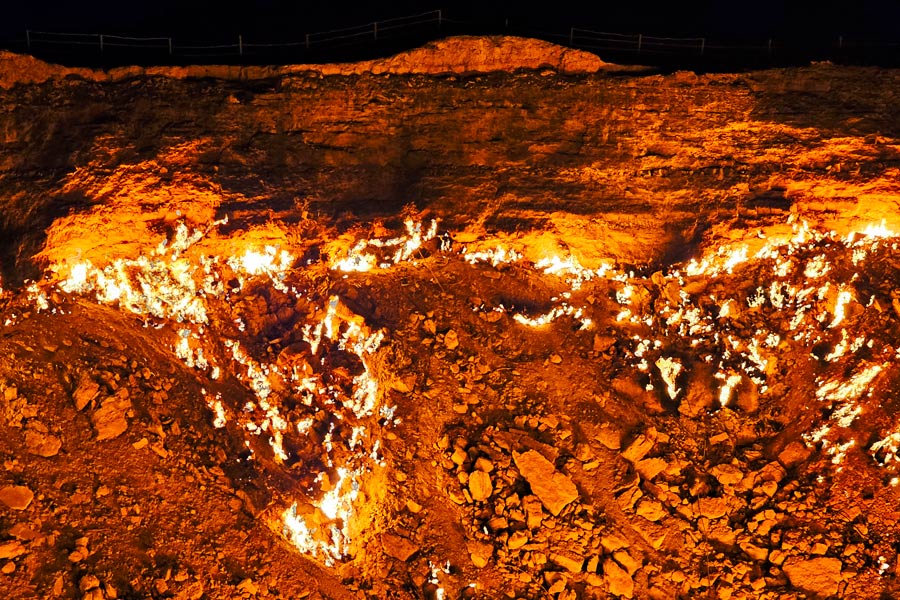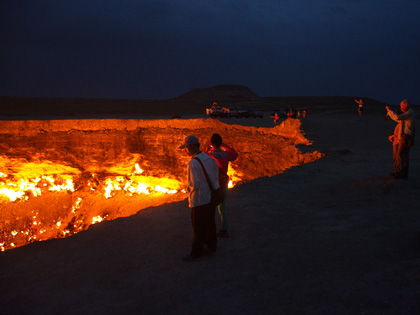Environmental Impact of the Darvaza Gas Crater

The Darvaza Gas Crater, located in the Karakum Desert, is a massive crater with a diameter of approximately 70 meters, where an eternal fire burns due to the continuous combustion of methane seeping from underground. This spectacular and mesmerizing phenomenon draws the curiosity of many visitors, who often question its impact on the environment. Given its constant release of methane – a potent greenhouse gas – it raises concerns about its potential contribution to climate change. We aim to explore whether the Darvaza Gas Crater plays a role in climate change, its effects on ecology, and whether efforts should be made to extinguish this extraordinary natural attraction.
Turkmenistan's Gas Emissions
In the global ranking of countries by methane emissions, the top positions are held by China, Russia, the United States, and India. However, when excluding domestic and agricultural sectors, Turkmenistan emerges as one of the leading contributors to industrial methane (CH₄) emissions. Over the past five years, the country has recorded more than 200 significant leaks of this potent greenhouse gas into the atmosphere. These emissions are primarily linked to large-scale accidental releases at oilfields, many of which still rely on outdated Soviet-era equipment and pipelines.
In recent years, Turkmenistan has been actively working to address this issue in line with its Global Methane Pledge (GMP) commitments. The government has been steadily reducing annual methane emissions by approximately 10%, demonstrating progress in mitigating environmental risks.
When it comes to carbon dioxide emissions, Turkmenistan does not pose a significant environmental threat. The country emits around 69 million tons of CO₂ annually, ranking 49th worldwide. In comparison, China, the world's largest emitter, releases over 12.5 billion tons of CO₂ each year – nearly 200 times more than Turkmenistan.
Darvaza Gas Crater Carbon Emissions
Due to the continuous emission and combustion of methane, the Darvaza Gas Crater releases tens of thousands of tons of carbon dioxide into the atmosphere each year. According to Kayrros, a company specializing in satellite-based global gas emission monitoring, the crater's CO₂ emissions were estimated at approximately 37,000 tons in 2021. This figure represents a decline of about 15% compared to data from several years earlier, a trend likely to continue as the gas pressure within the crater gradually decreases.
Darvaza Gas Crater Methane Emissions
There are no official records of methane emissions from the Darvaza Gas Crater, as they are considered negligible on a global scale. The majority of CH₄ released from the crater is combusted, converting into carbon dioxide and water vapor, with only a minimal amount escaping into the atmosphere. In fact, this ongoing combustion is the reason the crater remains aflame – Soviet scientists intentionally ignited the gas decades ago in an effort to mitigate its environmental impact.
Is It Necessary to Extinguish the Darvaza Gas Crater?
Although the "Gates of Hell" burns methane, converting it into carbon dioxide, which contributes to atmospheric pollution, the crater itself has no significant impact on global climate change:
- The amount of carbon dioxide emitted from the Darvaza Gas Crater is only about one-millionth of the world’s total carbon emissions. This means that extinguishing it would not make any noticeable difference in global CO₂ levels.
- Methane, the most dangerous greenhouse gas contributing to global warming, is released in only small amounts from the crater. While Turkmenistan is among the world’s top methane emitters, the Darvaza Crater plays no significant role in these emissions.
- On a national scale, putting out the flames would not lead to significant environmental improvements. The crater currently accounts for only about 0.1% of Turkmenistan’s total carbon dioxide emissions.
- When it comes to methane reduction, investing in modern infrastructure for the gas industry would be far more effective than extinguishing the crater, potentially cutting emissions by hundreds of times more than shutting down Darvaza.
In conclusion, extinguishing this world-famous crater would not contribute to improving atmospheric conditions or preventing global warming. However, it would mean the loss of one of the most unique and mesmerizing natural wonders on Earth.
Moreover, the process of extinguishing the Darvaza Gas Crater is technically challenging and could lead to unintended consequences. That's why the Darvaza Crater is still burning, as it has been for over 50 years.


